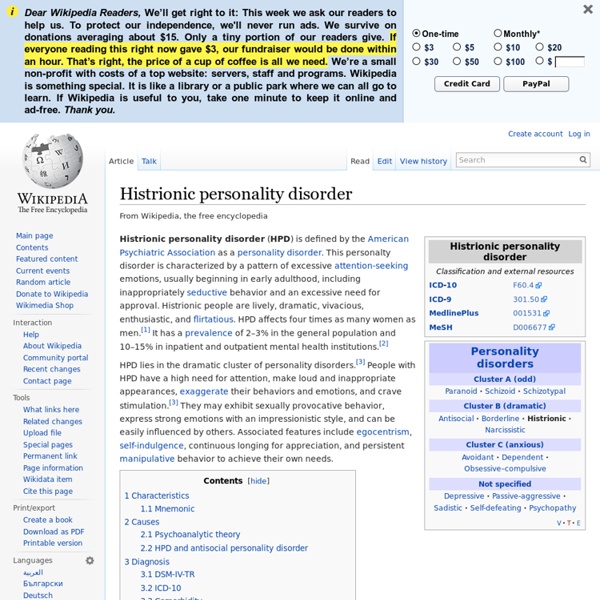



Histrionic Personality Disorder Histrionic Personality Disorder (HPD) HPD Introduction Histrionic Personality Disorder is characterized by an extreme interest in drawing the attentions of others, favorable or unfavorable, to oneself. HPD is estimated to affect up to 1% of the population. People who suffer from HPD are sometimes accused of being a "drama queen" or "drama major". HPD is a serious condition that isolates those who surround the people who have the disorder. A mnemonic that has sometimes been used to describe the criteria for histrionic personality disorder is “PRAISE ME”: P - provocative (or seductive) behavior R - relationships, considered more intimate than they are A - attention, must be at center of I - influenced easily S - speech (style) - wants to impress, lacks detail E - emotional liability, shallowness M - make-up - physical appearance used to draw attention to self E - exaggerated emotions - theatrical HPD Characteristics & Traits Self-Victimization - Casting oneself in the role of a victim.
Daniel A. Bochner, Ph.D. - Histrionic Personality Disorder Drama!!! That's what most people think of when they hear the word "histrionic." In fact, that's exactly what it means with respect to personality. Histrionic Personality is the term used to describe a person who engages in drama as the primary way of defending against the vulnerabilities they fear most. Typical traits of the Histrionic Personality include exaggerated responding, a need to be the center of attention, a seductive nature, extreme femininity in feminine histrionics and extreme masculinity in masculine histrionics, as well as a tendency to be easily influenced. Typically the development of the Histrionic Personality begins very early in life. Although the history of the Histrionic person typically involves a loving mother, and sometimes a loving father, as the child develops, there also tends to be dramatic conflict between their caretakers. Drama becomes a part of the picture for complex reasons. For the complete article, please buy The Emotional Toolbox book.